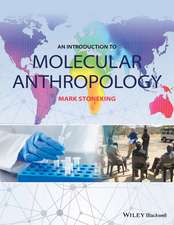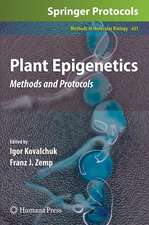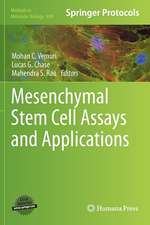2-D Proteome Analysis Protocols: Methods in Molecular Biology, cartea 112
Editat de Andrew J. Linken Limba Engleză Hardback – 24 sep 1998
| Toate formatele și edițiile | Preț | Express |
|---|---|---|
| Paperback (1) | 955.85 lei 43-57 zile | |
| Humana Press Inc. – 10 noi 2010 | 955.85 lei 43-57 zile | |
| Hardback (1) | 967.56 lei 43-57 zile | |
| Humana Press Inc. – 24 sep 1998 | 967.56 lei 43-57 zile |
Din seria Methods in Molecular Biology
- 9%
 Preț: 791.59 lei
Preț: 791.59 lei - 23%
 Preț: 598.56 lei
Preț: 598.56 lei - 20%
 Preț: 882.95 lei
Preț: 882.95 lei -
 Preț: 252.04 lei
Preț: 252.04 lei - 5%
 Preț: 802.69 lei
Preț: 802.69 lei - 5%
 Preț: 729.61 lei
Preț: 729.61 lei - 5%
 Preț: 731.43 lei
Preț: 731.43 lei - 5%
 Preț: 741.30 lei
Preț: 741.30 lei - 5%
 Preț: 747.16 lei
Preț: 747.16 lei - 15%
 Preț: 663.45 lei
Preț: 663.45 lei - 18%
 Preț: 1025.34 lei
Preț: 1025.34 lei - 5%
 Preț: 734.57 lei
Preț: 734.57 lei - 18%
 Preț: 914.20 lei
Preț: 914.20 lei - 15%
 Preț: 664.61 lei
Preț: 664.61 lei - 15%
 Preț: 654.12 lei
Preț: 654.12 lei - 18%
 Preț: 1414.74 lei
Preț: 1414.74 lei - 5%
 Preț: 742.60 lei
Preț: 742.60 lei - 20%
 Preț: 821.63 lei
Preț: 821.63 lei - 18%
 Preț: 972.30 lei
Preț: 972.30 lei - 15%
 Preț: 660.49 lei
Preț: 660.49 lei - 5%
 Preț: 738.41 lei
Preț: 738.41 lei - 18%
 Preț: 984.92 lei
Preț: 984.92 lei - 5%
 Preț: 733.29 lei
Preț: 733.29 lei -
 Preț: 392.58 lei
Preț: 392.58 lei - 5%
 Preț: 746.26 lei
Preț: 746.26 lei - 18%
 Preț: 962.66 lei
Preț: 962.66 lei - 23%
 Preț: 860.21 lei
Preț: 860.21 lei - 15%
 Preț: 652.64 lei
Preț: 652.64 lei - 5%
 Preț: 1055.50 lei
Preț: 1055.50 lei - 23%
 Preț: 883.85 lei
Preț: 883.85 lei - 19%
 Preț: 491.88 lei
Preț: 491.88 lei - 5%
 Preț: 1038.84 lei
Preț: 1038.84 lei - 5%
 Preț: 524.15 lei
Preț: 524.15 lei - 18%
 Preț: 2122.34 lei
Preț: 2122.34 lei - 5%
 Preț: 1299.23 lei
Preț: 1299.23 lei - 5%
 Preț: 1339.10 lei
Preț: 1339.10 lei - 18%
 Preț: 1390.26 lei
Preț: 1390.26 lei - 18%
 Preț: 1395.63 lei
Preț: 1395.63 lei - 18%
 Preț: 1129.65 lei
Preț: 1129.65 lei - 18%
 Preț: 1408.26 lei
Preț: 1408.26 lei - 18%
 Preț: 1124.92 lei
Preț: 1124.92 lei - 18%
 Preț: 966.27 lei
Preț: 966.27 lei - 5%
 Preț: 1299.99 lei
Preț: 1299.99 lei - 5%
 Preț: 1108.51 lei
Preț: 1108.51 lei - 5%
 Preț: 983.72 lei
Preț: 983.72 lei - 5%
 Preț: 728.16 lei
Preț: 728.16 lei - 18%
 Preț: 1118.62 lei
Preț: 1118.62 lei - 18%
 Preț: 955.25 lei
Preț: 955.25 lei - 5%
 Preț: 1035.60 lei
Preț: 1035.60 lei - 18%
 Preț: 1400.35 lei
Preț: 1400.35 lei
Preț: 967.56 lei
Preț vechi: 1179.96 lei
-18% Nou
Puncte Express: 1451
Preț estimativ în valută:
185.14€ • 193.82$ • 153.19£
185.14€ • 193.82$ • 153.19£
Carte tipărită la comandă
Livrare economică 07-21 aprilie
Preluare comenzi: 021 569.72.76
Specificații
ISBN-13: 9780896035249
ISBN-10: 0896035247
Pagini: 601
Ilustrații: XVII, 601 p.
Dimensiuni: 155 x 235 x 38 mm
Greutate: 1.08 kg
Ediția:1999
Editura: Humana Press Inc.
Colecția Humana
Seria Methods in Molecular Biology
Locul publicării:Totowa, NJ, United States
ISBN-10: 0896035247
Pagini: 601
Ilustrații: XVII, 601 p.
Dimensiuni: 155 x 235 x 38 mm
Greutate: 1.08 kg
Ediția:1999
Editura: Humana Press Inc.
Colecția Humana
Seria Methods in Molecular Biology
Locul publicării:Totowa, NJ, United States
Public țintă
ResearchCuprins
2-D Protein Gel Electrophoresis.- Solubilization of Proteins in 2-D Electrophoresis.- Preparation of Escherichia coli Samples for 2-D Gel Analysis.- Preparing 2-D Protein Extracts from Yeast.- 2-D Protein Extracts from Drosophila melanogaster.- Preparing 2-D Protein Extracts from Caenorhabditis elegans.- Eukaryotic Cell Labeling and Preparation for 2-D.- Differential Detergent Fractionation of Eukaryotic Cells.- Fractionated Extraction of Total Tissue Proteins from Mouse and Human for 2-D Electrophoresis.- Preparation and Solubilization of Body Fluids for 2-D.- 2-D Electrophoresis of Plant Proteins.- Quantifying Protein in 2-D PAGE Solubilization Buffers.- Measuring the Radioactivity of 2-D Protein Extracts.- Advantages and Disadvantages of Carrier Ampholyte IEF.- 2-D Electrophoresis Using Carrier Ampholytes in the First Dimension (IEF).- Nonequilibrium pH Gel Electrophoresis (NEPHGE).- High-Resolution, 2-D Protein Electrophoresis Using Nondedicated Equipment.- Large-Gel 2-D Electrophoresis.- Advantages of Immobilized pH Gradients.- Casting Immobilized pH Gradients (IPGs).- Analytical IPG-Dalt.- IPG-Dalt of Very Alkaline Proteins.- Running Preparative Carrier Ampholyte and Immobilized pH Gradient IEF Gels for 2-D.- In-Gel Sample Rehydration of Immobilized pH Gradient.- High-Resolution, IPG-Based, Mini Two-Dimensional Gel Electrophoresis.- Horizontal SDS-PAGE for IPG-Dalt.- Casting and Running Vertical Slab-Gel Electrophoresis for 2D-PAGE.- Nonreducing 2-D Polyacrylamide Gel Electrophoresis.- 2-D Diagonal Gel Electrophoresis.- 2-D Phosphopeptide Mapping.- Internal Standards for 2-D.- Autoradiography of 2-D Gels.- Double-Label Analysis.- Silver Staining of 2-D Electrophoresis Gels.- Staining of Preparative 2-D Gels.- Electroblotting of Proteins from 2-D Polyacrylamide Gels.- Detection of Total Proteins on Western Blots of 2-D Polyacrylamide Gels.- Protein Detection Using Reversible Metal Chelate Stains.- Glycoprotein Detection of 2-D Separated Proteins.- Image Acquisition in 2-D Electrophoresis.- Computer Analysis of 2-D Images.- 2-D Databases on the World Wide Web.- Comparing 2-D Electrophoretic Gels Across Internet Databases.- Constructing a 2-D Database for the World Wide Web.- Absolute Quantitation of 2-D Protein Spots.- Generating a Bacterial Genome Inventory.- Immunoaffinity Identification of 2-DE Separated Proteins.- 2-DE Spot Amino Acid Analysis with 9-Fluorenylmethyl Chloroformate.- N-Terminal Amino Acid Sequencing of 2-DE Spots.- Characterizing Proteins from 2-DE Gels by Internal Sequence Analysis of Peptide Fragments.- Obtaining Molecular Weights of Proteins and Their Cleavage Products by Directly Combining Gel Electrophoresis with Mass Spectrometry.- Identification of Proteins by Matrix-Assisted Laser Desorption/Ionization Mass Spectrometry Using Peptide and Fragment Ion Masses.- Sample Preparation Methods for Mass Spectrometric Peptide Mapping Directly from 2-DE Gels.- Protein Identification and Analysis Tools in the ExPASy Server.- Automated Protein Identification Using Microcolumn Liquid Chromatography-Tandem Mass Spectrometry.- Peptide Sequencing of 2-DE Gel-Isolated Proteins by Nanoelectrospray Tandem Mass Spectrometry.
Recenzii
"Our readers will find in this book with its 55 chapters, written by 78 highly well-trained specialists, all they need to come to a good result, going out from the theory of the subject to the precise description of the protocols, the instrumentation, to additive notes, the problems and the eventual difficulties. In one word, an excellent and practical book."-Cellular and Molecular Biology
"...There are 55 chapters covering everything you really need to know to get you to speed in the analysis of the proteome. I really liked the layout of each chapter with a pithy introduction followed by materials and methods sections...an absolute must for the proteomic laboratory."-Microbiology Today
". . .the book covers practical aspects , is well documented, and clearly written . . . recommended for researchers in the field. This collection of protocols is an invaluable starting point for people embarking on attempts to develop new proteomes."-FEBS Letters
"The wealth of techniques and helpful hints presented in this book should be useful to both neophytes and advanced researchers engaged in the area of high resolution 2-D protein electrophoresis."-Analytical Biochemistry
"...There are 55 chapters covering everything you really need to know to get you to speed in the analysis of the proteome. I really liked the layout of each chapter with a pithy introduction followed by materials and methods sections...an absolute must for the proteomic laboratory."-Microbiology Today
". . .the book covers practical aspects , is well documented, and clearly written . . . recommended for researchers in the field. This collection of protocols is an invaluable starting point for people embarking on attempts to develop new proteomes."-FEBS Letters
"The wealth of techniques and helpful hints presented in this book should be useful to both neophytes and advanced researchers engaged in the area of high resolution 2-D protein electrophoresis."-Analytical Biochemistry
Textul de pe ultima copertă
In 2-D Gel Proteome Analysis Protocols, Andrew Link and his expert collaborators take today's researchers step-by-step through the complete process of doing proteomics. With easy-to-follow instructions, complete with many helpful hints and explanations, leading investigators and pioneers in the field show how to make protein extracts, reproducibly run them on a 2-D gels, detect them, analyze the data, and precisely identify each protein. The book covers the latest methods of using carrier ampholytes in the 1st dimension, casting and running immobilized pH gradient 2-D gels, MALDI-TOF-based peptide mapping, automated tandem mass spectrometry, and nanoelectrospray ionization technology. For the 2nd dimension, there are methods for running flatbed or vertical gels and for protein detection using autoradiography, and Coomassie, silver, and reversible metal-chelate stains. The book is a perfect complement to the genome sequencing project for answering biological questions.
2-D Gel Proteome Analysis Protocols is the most complete guide for using proteomics to answer biological questions. Whether it is a question of global protein analysis or evaluating a cell's response to internal or external stimuli, the advanced methods described here will enable today's researchers better to understand how cells work and open new possibilities for drug discovery.
2-D Gel Proteome Analysis Protocols is the most complete guide for using proteomics to answer biological questions. Whether it is a question of global protein analysis or evaluating a cell's response to internal or external stimuli, the advanced methods described here will enable today's researchers better to understand how cells work and open new possibilities for drug discovery.
















